Storming of the Alb River Position
28th April 1800
Introduction and Initial Operations
by Roland Kessinger, Germany
| |
In spring 1800, the French Army of the Rhine under Jean Victor Moreau and the Austrian Army of Germany under Feldzeugmeister (FZM) Paul Freiherr von Kray, both over 100,000 strong, stood facing each other across the Rhine from its source near Chur (eastern Switzerland) to Mainz. Moreau had previously led already the Army of the Rhine &Moselle into southern Germany in 1796, which had been arranged in the standard 18th century formation of a main body, two wings and a reserve. Moreau proposed to arrange his Army of the Rhine in a similar fashion in March 1800, but as the components were now mostly larger than a division, Moreau used the 18th century term, corps (meaning either a body of troops larger than a division or a large detached formation of no specific size), to describe them.
The army, he wrote in a letter which accompanied his Chief of Staff Desolles to Paris to discuss campaign plans in mid-March, would be disposed in three corps with a division forming his left wing. His proposal was accepted by the new First Consul Napoleon Bonaparte in his response, except that the division was also referred to as a corps: The four corps of the Army of the Rhine would be led by Gilles Joseph Ste.-Suzanne (corps “Left Wing”), Gouvion St. Cyr (corps “Centre”), Claude Lecourbe (corps “Right Wing”), and Moreau himself (corps “Reserve”). The reply from Consul Bonaparte has been seized on by many authors subsequently as the start of the modern corps system -– but it was merely Moreau’s 1796 organisation and Bonaparte himself did not use any kind of permanent corps during his Second Italian campaign (Lannes’ “corps” had three different compositions in 5 weeks and Desaix’s corps lasted three days, fighting partly on the north side of the Marengo battlefield and partly crossing the Scrivia until it famously returned).
Devised during March, Bonaparte’s plan called for a double advance out of eastern Switzerland to cut the Austrian main lines of communication.
He anticipated that Kray’s Austrian army would concentrate west of the Black Forest near Donaueschingen, where its headquarters were located, so Moreau was to concentrate his army in northern Switzerland, cross the Rhine and cut the line of communication around the key crossroads at Stockach. Moreauu was unhappy with this highly risky plan. So, he proposed an alternative: using the
existing three bridgeheads of Kehl, Breisach and Huningen (today Klein-Hüningen near Basle), he would push three corps over the Rhine in the very south-western corner of Germany.
There were frequent exchanges between Moreau and Bonaparte about the plan throughout March, but a combination of supply problems and surprise news from Italy allowed Moreau’s plan to prevail, so in mid-April, his army prepared its assault. Nevertheless, Moreau still faced considerable problems: The government could not pay his soldiers, while supplies, horses for the artillery and much more were lacking. Only by stripping out the fortresses in Alsace could Moreau complete his preparations and concentrate his army.
In the early morning of 25th April 1800 the spring campaign in Germany started. However, the campaign was already not proceeding as Bonaparte expected. Confident that his propaganda would make Melas’ Austrian army stay in position around Turin, he was surprised to receive the news in mid-April that they had in fact already begun to move against Genoa. On 19th April, the vital port city and its garrison under General de Division (GD) André Masséna was under siege. To save this army Moreau had to advance as quickly as possible into Germany and to push back the Austrians to Bavaria. Only
then would Bonaparte have the opportunity to advance with his Reserve Army over the Alps by the shortest route: the Grand St Bernard, with his bases and communications in Switzerland safe from the threat of an Austrian attack from Germany into this vital area.
In the days prior to 25th April, additional French units were moved into the bridgeheads at Huningen, Breisach, and Kehl, which did not go unobserved by the Austrians. So it was not a complete surprise for FZM Kray, when Ste. Suzanne’s and St. Cyr’s two corps broke out from Kehl and Breisach respectively during the early morning of the 25th.
The weak Austrian observation forces, watching the Rhine valley bridgeheads, had to fall back during that day. Feldmarschallleutnant (FML) Michael Freiherrr von Kienmayer [Generalmajor (GM) Merveldt, GM Klenau, GM Löwenberg; 1. Merveldt Uhlans, 6. Blankenstein Hussars, 11. Latour Light Dragoons, Wurmser Freikorps (12 cos), 8. Gradiska Grenzer (1 bat), IR22 Lacy (1 bat), IR38 Württemberg (2 bat), IR55 Murray (2 bat)] retreated from Offenburg into the Kinzig valley, while GM Graf Ignaz Gyulai [3. Erzherzog Ferdinand & 12 Croat-Slavonian Hussars (2 squads?), 1st Battalion 13. Wallach-Illyrian Grenzers, 2nd Battalion 9. Peterwardein Grenzers, 5. Radivojevich Light Battalion, IR29 O. Wallis) withdrew slowly from Freiburg into the Höllental.
The corps 1st division under GD Antoine Guillaume Delmas was still camped between the river Wiese and the Rhine near Lorrach and Grenzach. The 2nd Division under GD Emanuel Leclerc was together with the cavalry Division under GD Jean Joseph d’Hautpoul further back in Alsace.
Once FZM Kray was informed by the telegraph system of the French attack, he started to concentrate his army around Donaueschingen as Moreau anticipated. Amongst the reinforcements sent to this area, FML Friedrich August Freiherr von Nauendorf was ordered to send IR2 Erzherzog Ferdinand, which had occupied the Rhine cordon with one battalion near Eglisau while two battalions were around Neunkirch to Donaueschingen.
At Donaueschingen, it joined the newly formed Corps de Reserve under FMLVincenz Kollowrat.
Tasked with defending the Rhine on the Switzerland-Germany border between Schaffhausen and Basle, FML Nauendorf’s corps was to play a key part in the events, which followed. After Nauendorf had detached IR2, he reorganised his force from his headquarters, which were at Stuhlingen on 25th April. The Austrian army used substantial detached forces, also referred to as corps, as standard practice –- Nauendorf himself having performed the same task in 1796. As the corps commander, assisted by his Chief of Staff, Oberst (Colonel) Jurzick, he was in direct contact with the commander-in-chief.
His CoS was a senior staff officer allocated from Army headquarters to assist in executing the Army command’s overall plan, but the corps command enjoyed independent operational control within that limitation.
Smaller corps or army detachments were led by a commander and a junior officer (usually a Major) from the Generalquartiermeisterstab (e. g. Major Purcel for GM Gyulai’s brigade). FML Nauendorf’s corps consisted of two divisions under the two GMs, Archduke Ferdinand d’Este and Graf O’Donell. Archduke Ferdinand held the line of outposts from the Hüningen bridgehead along the Rhine as far as
Tiengen, while GM O’Donell controlled the reserves positioned in the Stuhlingen-Tiengen area.
The outposts which would be vital in the next few days at Sackingen (today: Bad Sackingen), Wehr, and Zell, directed by Oberst Mecsery, commander of 10. Meszaros Hussars, reporting directly to Archduke Ferdinand. The outposts themselves were led by Oberstleutnant (Lt. colonel) Nordmann (10. Hussars) at Zell, Obristwachtmeister (Major) Spauer of the Tyrolean Jäger held Wehr and Oberstleutnant Rubinitz, commander of 12. Light Battalion commanded at Sackingen. The outposts themselves were occupied by a mixture of some companies of Tyrolean Jäger, 12. Light Battalion and some squadrons of the 10. Hussars. However, many Polish soldiers in 12. Light Battalion had started to become mutinous over the previous few days, so, GM Archduke Ferdinand proposed to swapping this battalion for troops from IR 31 Benjowsky or the Swiss mercenary Rovéréa Regiment.
It’s interesting to note that there was some grumbling and even a few actual mutinies right across the Austrian light infantry. A few days later, the Serb 2nd Battalion of 9. Peterwardein Grenzer under GM Gyulai refused to take orders and wanted to march to Vienna to address their complaints to Emperor Francis II. Whether this was a cause of the Light Infantry battalions being disbanded after the war ended needs further investigation – although cost was probably the main factor.
GM Archduke Ferdinand was to send 3 companies IR42 Erbach to Rafz, where they would be held as an immediate reserve. Oberst Stahel, commander of IR31, was allocated command of the cordon. To reinforce his depleted troops, Nauendorf ordered out the Landsturm, a local militia formed by the people of Vorderösterreich (the southern part of the Black Forest was an Austrian province at this time) and sent them to concentrate at the River Alb, focusing particularly on the defence of St. Blasien. FML Nauendorf now awaited the ex-pected the French attack from Hüningen.
Storming of the Alb River Position 28th April 1800
|
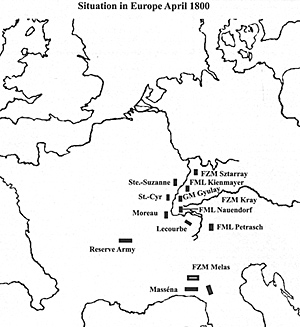 In First Empire 71, I looked at the organisation of the French and Austrian Army during the War of the Second Coalition. The opening clashes on the river Alb in the Black Forest (southern Germany) provide a good example, on the basis of which it is possi-ble to consider both the advantages and disad-vantages of the more flexible Austrian command structure.
In First Empire 71, I looked at the organisation of the French and Austrian Army during the War of the Second Coalition. The opening clashes on the river Alb in the Black Forest (southern Germany) provide a good example, on the basis of which it is possi-ble to consider both the advantages and disad-vantages of the more flexible Austrian command structure.
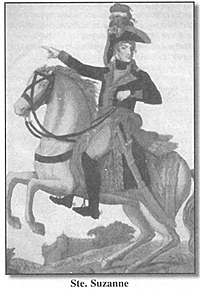 Ste.-Suzanne would cross at Kehl, St.-Cyr at Breisach, and Moreau himself at Huningen, before marching east into the southern and the Upper Rhine. Although this was a traditionalinvasion route into the area, Moreau believed he would still outflank the Austrians, while avoiding the danger of a river crossing without a bridgehead and the problems of concentrating his army in north-east Switzerland, which had been the scene of fighting in 1799. Only Lecourbe’s corps on the right would attempt a crossing of the Rhine without a bridgehead near Schaffhausen to take the Austrians in the rear.
Ste.-Suzanne would cross at Kehl, St.-Cyr at Breisach, and Moreau himself at Huningen, before marching east into the southern and the Upper Rhine. Although this was a traditionalinvasion route into the area, Moreau believed he would still outflank the Austrians, while avoiding the danger of a river crossing without a bridgehead and the problems of concentrating his army in north-east Switzerland, which had been the scene of fighting in 1799. Only Lecourbe’s corps on the right would attempt a crossing of the Rhine without a bridgehead near Schaffhausen to take the Austrians in the rear.
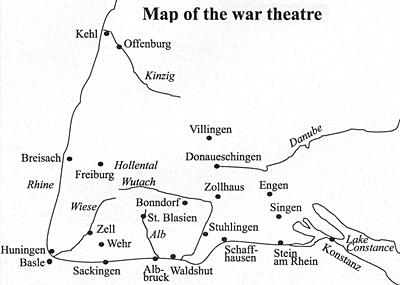 Initial Operations
Initial Operations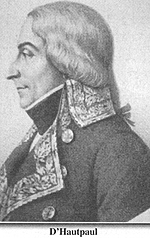 However, around Basle, there was little French activity -- Digonnet’s brigade from GD Antoine Richepance’s 3rd Division of the Reserve corps moved a short distance north towards Schliengen and Kandern.
However, around Basle, there was little French activity -- Digonnet’s brigade from GD Antoine Richepance’s 3rd Division of the Reserve corps moved a short distance north towards Schliengen and Kandern.
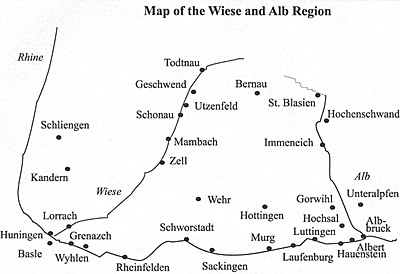 The Defence of the Upper Rhine
The Defence of the Upper Rhine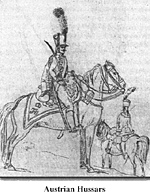 Once this news reached GM Archduke Ferdinand and then FML Nauendorf, the corps CinC ordered the swapping of two companies of the 12 Light Battalion with companies from IR31 or Roverea. However, Moreau’s initial advance seems to have prevented it being carried through, as was the case with another order, which intended to prevent one division (2 squads) of 12. Croat-Slavonian Hussars under Major Morberth being deployed on outpost duties. While FML Nauendorf was changing these dispositions, he was informed about the French attack at Kehl and Breisach, together with Kray’s order top despatch IR2. So Nauendorf ordered 3rd Battalion IR31 (4 cos) to replace one battalion of IR2 on the Rhine cordon between Eglisau and Neuhausen am Rheinfall.
Once this news reached GM Archduke Ferdinand and then FML Nauendorf, the corps CinC ordered the swapping of two companies of the 12 Light Battalion with companies from IR31 or Roverea. However, Moreau’s initial advance seems to have prevented it being carried through, as was the case with another order, which intended to prevent one division (2 squads) of 12. Croat-Slavonian Hussars under Major Morberth being deployed on outpost duties. While FML Nauendorf was changing these dispositions, he was informed about the French attack at Kehl and Breisach, together with Kray’s order top despatch IR2. So Nauendorf ordered 3rd Battalion IR31 (4 cos) to replace one battalion of IR2 on the Rhine cordon between Eglisau and Neuhausen am Rheinfall.